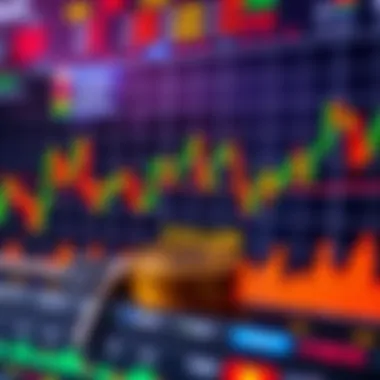Dynamics of the US Dollar and Indian Rupee Exchange


Intro
The landscape of currency exchange is akin to a shifting chessboard; every move is calculated, influenced by various players and factors. Within this intricate setup, the dynamics between the US Dollar and the Indian Rupee emerge as key points of interest for investors and traders alike. With the US Dollar often considered a safe haven and the Indian Rupee representing a rapidly growing economy, their relationship is worth dissecting. This examination is not merely academic; it holds implications for strategic investment, risk management, and economic forecasting. Understanding how these currencies interact is crucial for those looking to navigate the currency markets effectively.
There’s a wealth of information to unpack. The historical context sets a foundation, illustrating how events like economic policies and geopolitical tensions can sway exchange rates. Current trends reveal the fast-paced nature of the market, influenced by real-time economic indicators like interest rates, inflation, and employment data. Factors such as market sentiment can make the most stable currencies dance on a dime. This discourse seeks to illuminate these aspects, equipping the reader with insights that extend beyond mere numbers.
As we delve deeper, we’ll explore market analysis, dissect investment strategies, and ultimately aim to synthesize this information into actionable intelligence. Understanding the nuances in the interaction between the US Dollar and the Indian Rupee will empower traders and investors in their endeavors, helping to navigate through this ever-evolving landscape of currency exchange.
Historical Overview of the US Dollar and Indian Rupee
The historical context of the US Dollar and Indian Rupee serves as a foundational pillar in understanding their current dynamics in currency exchange. These currencies have not merely evolved in isolation; rather, their historical trajectories reflect broader economic, political, and social changes that resonate across global markets.
By examining the evolution of these currencies, one can glean insights into their respective economies, adapt to market fluctuations, and structure investment strategies effectively. A well-rounded understanding of their history can equip investors, traders, and analysts alike to make informed decisions.
Evolution of the US Dollar
The US Dollar has transitioned from its origins as a representative of commodity-backed value to a fiat currency, reflecting the shifting needs of international trade and economy. Instantly recognizable by the greenback hue of its notes, the US Dollar was established in the 18th century, primarily based on the Spanish dollar. The Coinage Act of 1792 marked its formal introduction, and from there, it began to find its footing in the American economy.
Significant milestones in its evolution include:
- 19th Century Gold Standard: Adopted officially in 1900, where the Dollar was backed by gold. This boosted global confidence, positioning the dollar as a stable medium of exchange.
- Bretton Woods Agreement (1944): It tied currencies to the US Dollar, which was convertible to gold, marking an unprecedented global economic shift.
- Nixon Shock (1971): The abandonment of gold standard meant the dollar became a fiat currency. This transformation arguably solidified its status as the world's dominant reserve currency.
Today, the dollar's strength results from its extensive acceptance in global trade and finance, backed by the size and influence of the US economy. The interconnectedness brought about by globalization has rendered it even more entrenched in international transactions.
Development of the Indian Rupee
Contrastingly, the Indian Rupee has a rich and intricate history that reflects the subcontinent's diverse cultural and economic landscape. Even before British colonial rule, the rupee had evolved through various forms, utilized in trade across different kingdoms.
Key points regarding its development include:
- Colonial Era Reforms: During British rule, the rupee underwent standardization and conversion into a currency that met the colonial administration's needs. The establishment of the Reserve Bank of India in 1935 marked a crucial turning point, as it became the sovereign authority over the rupee.
- Post-Independence Changes: Following independence in 1947, the Indian government implemented various reforms to stabilize the economy, which included changing the currency to reflect national sovereignty and image.
- Liberalization in 1991: The economic reforms initiated in the early '90s led to a more market-driven foreign exchange regime. This shift allowed the rupee to float freely against global currencies, responding to supply and demand factors.
The Indian Rupee continues to evolve, adapting to shifts in global economic conditions and domestic growth trajectories. Today, it is central in reflecting the interplay of India's vast economy with international markets.
In essence, understanding the historical evolution of the US Dollar and the Indian Rupee is vital. It lays the groundwork for recognizing present exchange trends and economic indicators at play.
In the following sections, we will delve deeper into current exchange rate trends, economic influences, and geopolitical factors that shape the currencies today.
Current Exchange Rate Trends
The landscape of currency exchange is constantly shifting, influenced by a myriad of factors. Understanding current exchange rate trends between the US Dollar and Indian Rupee is crucial for investors, traders, and analysts alike, who seek to optimize their strategies in this dynamic environment. These trends not only inform about the day-to-day movements of currencies but also reflect broader economic realities that can affect long-term investment decisions.
Focusing on exchange rate trends helps in identifying key patterns and cycles, which can signal potential opportunities or risks. A thorough grasp of these fluctuations is essential for anyone involved in currency trading, as it can guide their actions and strategies. Robust engagement with monthly and yearly trends provides insights into micro and macroeconomic factors, making this analysis indispensable in today’s interconnected global economy.
Monthly Fluctuations in the Exchange Rate
The movement in the exchange rate on a monthly basis tells a tale of shifting expectations and reactions to various economic news. For instance, if the US Federal Reserve hints at an interest rate hike, this could result in a strengthening of the Dollar. Conversely, any economic distress in India might lead to the Rupee losing ground against the Dollar.
Key factors that typically contribute to monthly fluctuations include:
- Economic Reports: Release of data such as GDP growth, unemployment rates, and manufacturing indices can sway investor sentiment rapidly.
- Political Events: Elections, policies, and geopolitical tensions can impact investor confidence, influencing currency strength dramatically. For example, a sudden announcement regarding trade tariffs could disrupt expected currency valuations.
- Market Sentiment: Speculative activities in currency markets can lead to sharp short-term changes that may not align with fundamental economic indicators.
"The currency market is like a living organism, reacting to stimuli constantly, and understanding these fluctuations is akin to reading its pulse."
Yearly Trends and Analysis
When we step back to look at yearly trends, a different picture emerges—one painted by broader economic cycles than monthly metrics reveal. Observing these trends can highlight how currencies respond over time to extended shifts in economic policy, inflation trends, and broader market movements.
Typical elements in yearly analysis that help in understanding the trend are:
- Interest Rate Trends: If the US maintains higher interest rates compared to India, the Dollar often appreciates. Looking back at the last couple of years showcases how shifts in interest rates can drastically alter trends.
- Inflation Rates: An understanding of inflation in both countries reflects on currency strength. A high inflation rate in India could lead to depreciation of the Rupee in the long run.
- Global Economic Environment: Not just local matters, the global economic conditions significantly impact yearly trends. Economic slowdowns in major markets like the Eurozone or China can reverberate through the USD/INR pair.
Understanding these year-long trends provides a lens through which to view the fundamental shifts that influence the market landscape. Collectively, investors and traders who keep their eyes on these trends can position themselves more strategically in anticipation of future movements in the USD/INR exchange rate.
Relevant Resources
- Federal Reserve Economic Data
- Reserve Bank of India
- Investopedia Currency Trading Explained
- World Bank Economic Indicators
Economic Indicators Influencing Currency Exchange
Economic indicators play a critical role in shaping the landscape of currency exchange, particularly when it comes to the US Dollar and the Indian Rupee. These indicators provide insightful data that traders and investors scrutinize closely to gauge the health of a country's economy and predict currency movements. For individuals navigating the complexities of forex trading, understanding these indicators enhances decision-making processes, enabling a proactive approach to market shifts.
The significance of economic indicators extends far beyond basic data. Interest rates, inflation rates, GDP growth, and unemployment figures, among others, function as beacons that illuminate the underlying economic conditions. As market players sift through these metrics, they develop a broader understanding of currency behaviors, often resulting in actionable strategies.
"Economic indicators do not merely inform; they influence the core strategies of trading and investing in currency markets."
While assessing economic conditions, it is essential to recognize the timing and context of these indicators' releases. For instance, surprising figures might trigger immediate market reactions, catching traders off guard. Conversely, predictable data releases could lead to preemptive positioning, which may or may not align with actual market performance.
Interest Rate Differentials
Interest rate differentials are often touted as one of the most influential economic indicators in foreign exchange. They represent the gap between the interest rates set by central banks of different countries. When the Federal Reserve raises rates in the United States while the Reserve Bank of India maintains lower rates, investors typically flock to the USD for its higher returns. This shift can create volatility in the USD/INR exchange rate, making it crucial for traders to monitor these changes.
The implications of interest rate changes are significant:
- An increase in US interest rates may strengthen the Dollar as capital flow shifts towards American assets.
- Conversely, if India raises rates, the Rupee might gain traction as it becomes more attractive to foreign investors.
Thus, interest rate differentials serve as a barometer for currency strength, making it vital for traders to keep their finger on the pulse of central bank policies and the prevailing economic landscape.
Inflation Rates Comparison
Inflation rates are another cornerstone of understanding currency exchange dynamics. Essentially, they measure the rate at which prices for goods and services rise, eroding purchasing power over time. High inflation in one country relative to another can lead to a depreciation of its currency.
When comparing the US and India, if inflation in India spikes while the US maintains stable rates, the Rupee may weaken against the Dollar. This can deter foreign investments and negatively impact trade balances. Therefore, a rising inflation trend in India can create stress on its currency position. On the other hand, low inflation in the US can enhance the Dollar's appeal, safeguarding investor confidence.
To synthesize the information:
- Higher relative inflation prompts depreciation of a currency.
- Monitoring inflation across both economies can help forecast currency movements.
Ultimately, navigating the complexities of currency markets demands a nuanced understanding of economic indicators. By keeping a close eye on interest rate differentials and inflation rates, investors and traders can harness key insights to inform their strategies and approach to the USD and INR exchange landscape. Understanding these elements fosters confidence in decision-making in a rapidly changing environment.
Geopolitical Factors at Play
Geopolitical factors significantly shape the landscape of currency exchange, particularly impacting the relationship between the US Dollar and the Indian Rupee. These factors include international policies, military conflicts, and diplomatic relations, which can create ripples across global markets. Understanding these influences helps investors and traders navigate the complexities of currency trading, especially in a world that's tightly interconnected.
Impact of US Policy on Indian Currency
US policies wield considerable influence over many international currencies, with the Indian Rupee being no exception. When the US makes moves regarding interest rates, trade agreements, or economic sanctions, the effects can be felt thousands of miles away in India.
- Interest Rate Decisions: When the Federal Reserve adjusts its interest rates, it directly impacts investor sentiment. A rise in US rates typically leads to a stronger US Dollar, prompting outflows from emerging markets, including India. This shift can devalue the Rupee, making imports expensive and leading to inflation.
- Trade Policies: Changes in trade agreements or tariffs can affect the flow of goods and services between the US and India. For instance, if the US imposes tariffs, Indian exports may decline, resulting in a weaker Rupee against the Dollar. Such a scenario creates uncertainty in the markets, deterring investors and increasing volatility.
- Geopolitical Strategies: The US's strategic interests, especially in South Asia, often intertwine with its economic policies. When the US aligns itself with certain countries for military or economic reasons, it can result in either support or deterrence for India, thereby affecting trade and investment flows crucial for the strength of the Indian Rupee.
"The interplay between US policy and Indian currency is a dance that investors cannot overlook. A single twist in policy can lead to significant shifts in currency dynamics."
Regional Stability and Currency Strength
Regional stability plays a crucial role in determining the strength of the Indian Rupee amidst its competition with the US Dollar. Political stability, economic performance, and socio-cultural factors can greatly influence currency exchange rates.
- Political Stability: Countries experiencing unrest or uncertainty often see their currencies weaken. India's geopolitical landscape involves its neighbors, and any instability—such as border conflicts or political turmoil—can adversely affect the Rupee. Stability engenders trust among foreign investors, which in turn supports the currency.
- Economic Partnerships: Initiatives that foster economic collaboration, like investments from international firms or joint ventures, tend to stabilize the Rupee. An increase in foreign direct investment indicates confidence in India's economic policies, creating a more favorable environment for the Rupee.
- Socio-Economic Conditions: Public sentiment and economic health impact the currency's reputation. Issues like employment, inflation, and public spending are indicators of economic stability. A healthy economy generally translates to a stronger currency, boosting investor confidence.
- Global Partnerships: India's engagement in global forums and partnerships—like BRICS or its relationship with ASEAN—also affects its geopolitical standing. Positive relationships allow for economic cooperation, leading to a more robust currency position in comparison to the Dollar.
Market Sentiment and Currency Movement
Market sentiment plays a pivotal role in the dynamics of currency exchange, particularly between the US Dollar and the Indian Rupee. Investors and traders constantly maneuver through an ocean of information, trying to decode the collective mood of market participants. Sentiment, a blend of emotional responses to economic events, political occurrences, and social conditions, can drive currency values significantly more than fundamentals alone. Factors such as news reports, investor outlook, and even social media chatter contribute to shaping this sentiment, hence influencing volatility in currency markets.


Understanding these dynamics helps in grasping how sentiment affects currency demand and supply. For example, when news surfaces indicating a potential economic downturn in the US, sentiment can shift rapidly. Traders may sell off the Dollar, leading to a depreciation against the Rupee. This behavior underscores the importance of being attuned to market sentiments, as they can result in unexpected market moves.
Moreover, sentiment analysis provides insights into investor behaviors, enabling traders to make informed decisions. Unlike traditional economic indicators, which represent hard data, sentiment reveals the psychological factors at play. Given the active interest from both domestic and foreign players in the USD/INR pair, understanding how market sentiment can sway demand becomes essential.
Role of Speculators in Currency Markets
Speculators are often seen as the driving force in currency markets, acting on short-term expectations to capitalize on price movements. They tend to analyze trends, reacting swiftly to news and data releases that could influence currency values. This behavior creates irregularities in the market, leading to fluctuations that may not reflect the underlying economic realities of either the US or India.
It’s important to understand how speculation functions in currency trading. Here are some key points:
- Market Liquidity: Speculators provide liquidity, making it easier for others to buy and sell currencies. More liquidity can lead to more stable prices, at least on the surface.
- Volatility Induction: While liquidity is crucial, speculative trading can also induce volatility, especially during uncertain times. A sudden weather report suggesting a poor monsoon season in India might spur selling pressure on the Rupee by speculators.
- Expectational Dynamics: Speculators often trade based on their expectations of future market conditions. This anticipatory behavior can be a double-edged sword, as it might sometimes overshoot the mark, leading to sharp corrections thereafter.
Speculators are not just a side-show; they are the lifeblood that can accelerate movements, regardless of economic health.
Behavioral Finance and Currency Trading
Behavioral finance delves into the psychological influences that affect financial decision-making. In the context of currency trading, this becomes particularly interesting. Traders often make decisions that aren't purely based on rational analysis. Instead, they respond to emotional triggers stemming from fear, greed, overconfidence, and even herd mentality.
For instance, during periods of economic uncertainty, traders might experience heightened fear, prompting them to sell their Dollar holdings. Similarly, during a string of positive news announcements regarding India's economic outlook, greed could spur a rush to buy the Rupee, sometimes without solid backing data.
Key Behavioral Tendencies in Currency Trading:
- Herd Behavior: Investors may follow large players or trends, sometimes leading to bubbles or crashes.
- Anchoring: Traders can sometimes cling to initial pieces of information, leading them to misprice currency positions as new information emerges.
- Over-Confidence: An irrational level of confidence can lead traders to take excessive risks, exposing them to greater losses.
By drawing on concepts from behavioral finance, traders can recognize these biases in themselves and others, ultimately leading to more informed trading strategies. As they become aware of their cognitive biases, they can adjust their trading behavior, reduce irrational losses, and potentially enhance profitability.
Investing in Currency Markets
Investing in the foreign exchange market is now easier than ever. This dynamic and fast-paced environment offers numerous opportunities for traders and investors, particularly when dealing with major currencies like the US Dollar and Indian Rupee. Understanding how to navigate this terrain provides a myriad of potential benefits.
The first essential aspect to grasp is liquidity. Forex markets are among the most liquid globally, meaning there is always the opportunity to buy or sell currency pairs. This characteristic allows traders to enter and exit positions with relative ease, often at favorable prices. High liquidity translates to tighter spreads, enhancing the potential profitability of trades.
Additionally, the use of leverage presents another tool for investors. With the ability to control larger amounts of capital with a relatively small investment, traders can amplify both gains and losses. It’s a double-edged sword, thus careful risk management becomes crucial. High-stakes trading can yield significant returns, but it's equally fraught with the potential for substantial losses if one's strategy is flawed.
When one considers trading the USD/INR pair, it becomes apparent how geopolitical and economic factors influence currency movements. For instance, changes in interest rates, economic data releases, and central bank policies can cause sharp fluctuations in this exchange rate. Understanding these nuances is vital for successful trading.
Another thought-provoking element is the aspect of diversification. Currency markets can serve as an effective tool for investors looking to spread risk across different assets. When economies behave differently, taking positions in various currencies can mitigate risks associated with domestic markets. For example, if economic conditions in India falter, a strong performance from the US economy could offset losses incurred from INRs decline.
On that note, risk management must remain front and center in trading strategies. The necessity of implementing stop-loss orders and limiting the amount of capital risked on any single trade cannot be overstated. It’s essential to acknowledge that currency markets can fluctuate wildly based on news events or market sentiment. Moreover, keeping abreast of global economic indicators, from inflation rates to employment statistics, informs better trading decisions.
"In the world of currency trading, knowledge is power. Familiarity with market trends and economic shifts can dramatically change the game".
Lastly, continuous education is imperative for anyone looking to invest in Forex. Staying updated on market analysis and trends can guide traders in making informed decisions. Resources like Investopedia, Forex Factory, and scholarly articles found through JSTOR can be invaluable.
Strategies for Trading USD/INR
Understanding how to effectively trade the USD/INR currency pair is crucial in the current economic landscape. Factors such as market volatility, economic indicators, and geopolitical events can cause significant fluctuations in the exchange rate. This dynamic can offer both opportunities and risks for traders. Consequently, having well-defined strategies in place becomes imperative for making informed trading decisions.
Technical Analysis in Currency Trading
Technical analysis thrusts itself into the limelight when one aims to predict price movements based on historical price data. Traders utilize charts, patterns, and various indicators to assist in framing their decision-making process.
- Chart Patterns: One can identify bullish or bearish patterns to predict potential price movements. Patterns like the head and shoulders or double tops/bottoms become essential in discerning market sentiments at a glance.
- Indicators: Tools like moving averages, Relative Strength Index (RSI), and Bollinger Bands serve the purpose of identifying trends and entry/exit points. For instance, if the RSI indicates that the USD is overbought, a trader might want to consider selling, while a move towards an oversold condition might trigger a buy signal.
- Time Frames: Different time frames—daily, weekly, or intraday—offer unique insights for various trading strategies, such as swing trading or day trading, thus allowing traders to adapt their approach based on their goals and risk tolerance.
By keeping an eye on these elements, traders can potentially harness price movements driven by market trends. Effective use of technical analysis can help in positioning oneself favorably in the USD/INR market.
Fundamental Analysis Considerations
While technical analysis focuses on price movements, fundamental analysis peers deeper into the economic and financial indicators that govern currency values.
- Economic Indicators: GDP growth rates, employment statistics, and manufacturing data are all pivotal in understanding economic health. For instance, a strong GDP growth rate in the U.S. compared to India may strengthen the USD against the INR.
- Interest Rates: Traders must examine interest rate trends set by the Federal Reserve and the Reserve Bank of India. A higher interest rate in the U.S. may attract foreign investment, leading to a stronger dollar.
- Political Stability: Currency value is often influenced by the political climate. For example, uncertainty around U.S. elections may render traders cautious, impacting the USD’s performance.
- Global Events: Unexpected events like natural disasters or geopolitical tensions can rapidly alter economic conditions and, consequently, currency valuations.
"Understanding these fundamental aspects can empower traders, ensuring that their strategies are aligned with broader economic realities rather than mere price movements."
Incorporating both technical and fundamental analyses creates a robust framework for trading the USD/INR currency pair. Utilizing these strategies enables traders to navigate the complexities of the market with greater clarity.
Future Projections for USD/INR Exchange Rate
Understanding future projections for the USD/INR exchange rate is not just an academic exercise; it’s a vital roadmap for investors, traders, and policymakers alike. With currency exchange being a core component of global finance, grasping what the future holds allows market participants to craft informed strategies and minimize risks. Investors keen on the Indian market need to recognize that fluctuations in the USD/INR can significantly affect import costs, investment returns, and international purchasing power.
Some critical elements to consider in these projections include interest rates, inflation levels, geopolitical stability, and economic growth in both countries. For example, if the Federal Reserve raises interest rates, the dollar often appreciates against the rupee, assuming all else remains constant. Thus, understanding these dynamics aids investors in making more strategic decisions, potentially maximizing returns while mitigating adverse outcomes.
Moreover, these projections also have a direct influence on trade balances. A weakening rupee could inflate the price of imports for India, leading to trade deficits, which in turn affects government policies. In similar fashion, the repercussions are felt on the U.S. side, especially as trade relations evolve.
If done right, leveraging future predictions about the USD/INR could provide unique opportunities for risk management through currency hedging or strategic forex trading techniques.
Predictions Based on Current Trends
Current trends provide insights that can serve as a starting point for projections. The integration of economic data, such as GDP growth rates from both nations or employment statistics, gives weight to forecasts, unveiling potential future paths for the exchange rate. Recent data has indicated that as India continues to grow at a faster pace than the U.S., some analysts speculate a gradual strengthening of the rupee against the dollar in the long-term.
Furthermore, the changing dynamics of the international market pose questions about long-term USD supremacy. If India can successfully leverage its young workforce and bolster manufacturing in view of the 'Make in India' initiative, then the USD/INR might experience shifts favoring the rupee over the next few years.
Predicting outcomes based on these trends, however, demands careful consideration of unexpected shocks—economic or otherwise.
Potential Market Shocks and Impacts
Market shocks can swiftly reshape the landscape of currency exchanges, often leading to volatility that upsets routine trader expectations. For instance, geopolitical turmoil, such as a sudden conflict in a region that affects oil prices, can prompt immediate responses in the USD/INR. Another example might be significant changes in trade agreements or tariffs implemented by either country.
Moreover, global crises, such as the recent pandemic or financial meltdowns, serve as stark reminders that the currency market can be incredibly unpredictable. The effects ripple through economies, resulting in economic slowdowns that could weaken the rupee while simultaneously testing the resilience of the dollar.
"Understanding the potential of these shocks is crucial. They can redefine the contours of trading strategies overnight, compelling traders to rethink their market positions and risk exposures."
Thus, those engaged in the currency markets must remain vigilant and adaptive to not just identified trends but also to the looming uncertainties that threaten to tip the scales unpredictably.
In summary, while predicting the USD/INR is an intricate endeavor, a comprehensive analysis of current trends and anticipated shocks equips investors with a stronger grasp on future shifts, helping them navigate the currency landscape astutely.
Legal and Regulatory Framework
The legal and regulatory framework surrounding currency exchange plays a crucial role in ensuring market integrity, protecting investors, and facilitating fair trading practices. Understanding the rules and regulations that govern the exchange of the US Dollar (USD) and Indian Rupee (INR) is essential for investors and traders looking to navigate the forex market. By grasping this framework, one can better appreciate the forces that shape currency values and the associated risks involved in trading. Here are some key points to consider regarding the regulatory environment:
- Market Integrity: Regulations ensure that currency markets operate in a fair and transparent manner, helping to prevent manipulation and fraud.
- Investor Protection: Legal frameworks often include guidelines that protect investors from unethical practices, providing a safety net for individual traders.
- Reporting Standards: Regulations typically require reporting of certain transactions that can be valuable for analysis and accountability.
- Cross-border Considerations: Given that currency trading often involves multiple jurisdictions, understanding how these regulations interact is crucial for trading decisions.
"Knowledge of the legal frameworks under which currencies operate is like having a roadmap when you are driving through unfamiliar territory."
Understanding Forex Regulations in India
The Reserve Bank of India (RBI) plays a pivotal role in regulating the foreign exchange market in India. Its policies govern the buying and selling of foreign currencies, including the Indian Rupee. Understanding these regulations is vital for anyone looking to trade INR against the USD. Some important aspects include:
- Current Account and Capital Account Transactions: India has regulations that differentiate between current account transactions, which are usually free, and capital account transactions, which are subject to strict controls. Investors need to navigate these distinctions carefully.
- Foreign Currency Accounts: The RBI allows residents to open specific accounts in foreign currencies; however, the conversion and repatriation rules apply differently to residents and non-residents.
- Reporting Requirements: Certain transactions must be reported, primarily by authorized banks and dealers, making it essential for traders to work within established guidelines to ensure compliance.
Understanding these regulations minimizes legal risks while maximizing opportunities in the Indian currency markets.
US Regulations Affecting Currency Trading
In the United States, several regulatory bodies oversee currency trading practices. The primary ones include the Commodity Futures Trading Commission (CFTC) and the Securities and Exchange Commission (SEC). Their influence permeates trading practices involving USD. Key elements include:
- Regulatory Oversight: The CFTC monitors derivatives markets, including forex, to prevent fraud and ensure ethical practices.
- Registration and Compliance: Brokers and trading platforms operational in the US must comply with strict registration requirements and adhere to operational guidelines, ensuring trades are conducted safely and transparently.
- Investor Education: Regulators emphasize the importance of investor education, providing resources for traders to understand risk management strategies and market functioning.
Investors trading USD/INR should keep abreast of these regulations. Ignoring legal constraints can lead to costly consequences, making comprehensive knowledge vital for successfully navigating the currency exchange landscape.
For more information on these regulations, you can visit:


- Reserve Bank of India
- CFTC
- SEC
- Investopedia - Understanding Forex Regulations
- Forex Trading Regulation: A Global View
Impacts of Currency Fluctuations on the Economy
Currency fluctuations have a profound influence on the broader economy, impacting everything from the cost of imports and exports to foreign investment flows. For investors, traders, and analysts, understanding these dynamics is crucial, particularly when dealing with major currencies like the US Dollar and the Indian Rupee.
When the value of a currency changes, it affects the price of goods sold internationally. A stronger US Dollar means that American exports become more expensive for foreign buyers, often leading to a decrease in demand from overseas markets. Conversely, a weaker Dollar usually results in cheaper US goods abroad, which can stimulate exports. The implications here are significant for trade balances – if exports decrease and imports become cheaper, a country can find itself with a trade deficit, something that can weaken its currency in the long run.
Moreover, currency strength impacts investment flows. Investors seeking stable markets will often gravitate towards stronger currencies, viewing them as a safer bet. When the Indian Rupee weakens against the Dollar, it can signify instability, causing foreign investors to hesitate. They might channel their funds to economies where currency valuations seem secure. This creates a feedback loop; declining investment inflows help further weaken a currency, affecting local businesses and economic growth.
After all, it’s a chain reaction.
"The strength of a currency reflects the economic health of a nation. Fluctuations are to be analyzed just as closely as the economic indicators themselves."
The benefits of paying attention to currency fluctuations are ample. Being proactive can mitigate risk when engaging in markets or when investments are concerned. Companies that export goods often hedge against currency risks to ensure they are not adversely affected by sudden exchange rate changes.
Effects on Trade Balances
Trade balances are directly influenced by currency strength and fluctuations. When the US Dollar strengthens against the Indian Rupee, Indian consumers face higher prices for American goods. This could lead to a decrease in demand for exports from the US to India. Conversely, when the Rupee strengthens, Indian products become more attractive to American buyers, potentially improving India's trade balance.
A few key points to consider:
- Price Sensitivity: Exporters need to be aware of how price changes impact sales volume.
- Market Penetration: Strong currency can be a barrier for entry into a new market.
- Long-Term Strategies: Companies may need to reconsider their pricing strategies based on constant currency changes.
Investment Flows and Currency Strength
The correlation between currency strength and investment flows cannot be overstated. A robust currency often signifies stable economic conditions that attract investment. Investors typically prefer markets where they can grow their investments without the fear of fluctuating currency. If the Rupee depreciates significantly, it signals instability and can deter foreign direct investment, furthering economic challenges for India.
Important considerations include:
- Foreign Direct Investment (FDI): A stable currency attracts long-term investors, while volatility drives them away.
- Portfolio Investment: Currency shifts can affect the returns on investments, prompting investors to seek opportunities elsewhere.
- Global Competitiveness: Companies in countries with weaker currencies might rely heavily on exporting goods, which also affects inward investments.
In summary, currency fluctuations can reshape economic realities. Understanding these impacts is critical for making informed investment decisions and drafting strategies that remain resilient amidst the waves of change in global currency markets.
Role of Central Banks
Central banks play a pivotal role in the currency dynamics of a nation, influencing not just local economies but also the international landscape. When examining the relationship between the US Dollar and the Indian Rupee, the actions and policies of the Federal Reserve and the Reserve Bank of India cannot be overlooked. These institutions help stabilize their respective currencies, often acting as a balm during times of economic uncertainty.
The primary functions of central banks include setting interest rates, regulating money supply, and serving as a lender of last resort. Moreover, they are crucial in maintaining financial stability and can wield considerable influence over exchange rates through market interventions and policy announcements. This makes their decisions closely watched by traders and investors who thrive on trends, speculations, and forecasts.
Key elements regarding the role of central banks in the context of USD/INR currency exchange include:
- Interest Rate Adjustments: Changes to interest rates can lead to immediate currency shifts. For instance, if the Federal Reserve raises rates, it often leads to a stronger US Dollar against the Rupee.
- Monetary Policy Announcements: The language and tone used by central banks during policy releases can drive market sentiment, leading to volatility immediately after such announcements.
- Intervention in Forex Markets: Both the Federal Reserve and the Reserve Bank of India can influence currency values by directly buying or selling currencies. This type of intervention is typically a response to excessive volatility.
Being informed about central bank activities offers investors and traders a strategic edge. By understanding how these institutions operate, one can better anticipate potential shifts in currency values and adjust investment strategies accordingly.
"The actions of central banks can create ripples across global markets; knowing how to read those ripples is essential for successful investment."
Federal Reserve's Influence on the USD
The Federal Reserve, often referred to as the Fed, is the backbone of the United States' monetary system. One of its most crucial responsibilities is to manage inflation and ensure maximum employment. These dual mandates shape financial policy decisions and, consequently, the strength of the US Dollar.
When the Fed decides to raise interest rates, it usually attracts foreign capital seeking higher returns, which boosts the demand for the USD. Conversely, lowering interest rates can lead to capital flight and a depreciating Dollar. Moreover, the Fed's stance on inflation also matters; if inflation rises above desired levels, it may prompt aggressive rate hikes, leading to a stronger Dollar against other currencies, including the Indian Rupee.
Recent examples illustrate how the Fed's interest rate decisions can swing the currency landscape:
- After the pandemic, the Fed maintained a accommodative stance, resulting in a weaker Dollar.
- As the economy displayed signs of recovery, the Fed hinted at potential rate hikes, which in turn strengthened the Dollar, impacting the USD/INR exchange rate.
Such decisions don’t just affect intra-country dynamics. They echo in the Forex market, affecting investment flows to and from India.
Reserve Bank of India's Policies and Impact
The Reserve Bank of India (RBI) acts as the custodian of the Indian economy and holds the responsibility for formulating and executing monetary policy. The RBI aims to maintain price stability while ensuring monetary growth, two critical factors that play into the strength of the Indian Rupee.
One notable aspect of RBI’s policy making is its focus on inflation control. High inflation in India can lead to policy tightening, thereby appreciating the Rupee against its global counterparts. Like the Federal Reserve, the RBI uses interest rates as a key tool; a hike usually attracts foreign investment, enhancing Rupee value.
The RBI also intervenes in the Forex market to curb excessive volatility in the Rupee. Such interventions may happen when the Rupee depreciates sharply, which can lead to economic instability. Furthermore, any announcements related to foreign exchange reserves or changes to the Money Market can significantly influence the Rupee's strength.
In recent times, the RBI has been active in addressing issues like:
- Inflation Targeting: Following a strict inflation-targeting framework to maintain currency stability.
- Forex Reserves Management: Generating favorable conditions for the currency by managing the country's foreign reserves effectively.
- Collaboration with Other Countries: Engaging in dialogues with various nations for trade agreements, which indirectly benefit currency strength.
By keenly observing the RBI's actions, investors can glean insights into future movements of the Indian Rupee and how it might respond to changes in both domestic and foreign monetary policy.
Global Economic Relationships
The interplay between the US Dollar and the Indian Rupee is deeply influenced by a network of global economic relationships. These interactions shape the currency exchange landscape, creating a fabric where trade balances, investment flows, and policy decisions weave together. Understanding these relationships helps investors, traders, and analysts navigate the complex waters of currency trading, offering essential insights into potential market movements.
Impact of Global Markets on USD and INR
In a world that feels increasingly interconnected, the movement of currencies is seldom borne out of domestic factors alone. Global markets tick in harmony and discord, creating ripples that influence exchange rates. When economic indicators point to growth or contraction in major economies—be it the Eurozone, China, or others—the impact is often felt in the value of the US Dollar and Indian Rupee.
Consider this: when market sentiment shifts toward risk aversion, investors instinctively retreat to the safety of the US Dollar, pushing its value higher. Conversely, in times of economic buoyancy, risk assets, including currencies from emerging markets like India, tend to flourish. This ebb and flow not only shapes the immediate currency exchange rates but also establishes long-term trends—making it imperative for traders to stay attuned to global economic cues.
"The value of a currency is never an isolated island; it is part of a much larger economic chain that extends across the globe."
Key influences on the USD/INR pair include:
- International Trade Dynamics: Trade relations between nations can substantially affect their currencies. A trade surplus may embolden a currency, while a deficit might weaken it.
- Global Economic Indicators: Factors such as GDP growth rates, employment numbers, and consumer confidence in major economies tend to sway currency values.
- Shift in Investments: As global investors search for the best returns, they often allocate funds based on risk assessments that include currency strength.
Bilateral Trade Relations between the US and India
Bilateral trade relations between the US and India are significant and multifaceted. With a partnership that has grown stronger over decades, trade not only defines economic ties but also affects currency stability and growth.
The US is one of India's largest trading partners, exporting goods ranging from machinery to pharmaceuticals. In contrast, India exports a plethora of items, including textiles and IT services. This exchange influences how both currencies perform against one another.
Consider the following:
- Trade Policies: Changes in tariffs or trade agreements lead to shifts in trade flows. For instance, the renegotiation of trade terms can bolster the Rupee if India's exports increase significantly to the US.
- Investment Flows: The amount of foreign direct investment flowing into India from the US also impacts the Rupee's value. More investment can boost the Rupee's strength, whereas capital outflows can lead it to depreciate.
- Market Sentiments: Political relations and economic cooperation foster confidence, which can reinforce currency strength. Positive sentiment around bilateral relations can lead to appreciation in the Indian Rupee, while negative news can have the opposite effect.
In summary, understanding the nuances of these bilateral trade relations is vital for anyone looking to grasp the dynamic between the US Dollar and Indian Rupee. It underlines the necessity for continuous monitoring of economic data, trade policies, and geopolitical developments to make well-informed decisions in the currency market.
For more detailed trade statistics and insights, you may refer to resources such as U.S. Census Bureau and Ministry of Commerce and Industry, India.
Hedging Strategies for Investors
In the realm of currency exchange, particularly for currencies as significant as the US Dollar and the Indian Rupee, hedging strategies can be a game-changer for investors. Hedging is all about mitigating risks associated with fluctuating currency values. For investors looking to maintain their profit margins or protect their investments, a well-thought-out hedging approach is crucial. As these currencies are often subject to a myriad of economic and geopolitical factors, understanding how to hedge effectively can make the difference between profit and loss.
One of the main benefits of implementing hedging strategies is the insulation from abrupt price changes. For instance, a sudden spike in the US Dollar's worth could erode the value of investments pegged against the Indian Rupee. Without proper hedging, investors might find themselves at a disadvantage, facing unexpected losses. Hence, the importance of having a robust hedging strategy cannot be overstated.
When considering hedging, several elements come into play:
- Types of Derivatives: Understanding the derivatives market is essential for any investor looking to hedge. Derivatives can range from forward contracts to options and futures, each with its nuances and advantages.
- Market Timing: Successful hedging also involves knowing when to enter or exit the market. Poor timing can diminish the effectiveness of hedging strategies.
- Cost Analysis: While hedging offers protection, it can also incur costs. Investors must weigh the costs versus the benefits to determine the most economical strategy.
Using Derivatives to Mitigate Risk
Derivatives are financial instruments whose value derives from the value of an underlying asset. In currency trading, they act as tools for investors to hedge against unfavorable price shifts in the US Dollar and Indian Rupee. There are several types of derivatives that investors can utilize:
- Currency Forwards: These contracts lock in an exchange rate for a future date, allowing investors to secure prices and ward off volatility.
- Currency Options: These contracts give investors the right, but not the obligation, to exchange currency at a specified rate before a particular date. They provide flexibility, which can be advantageous in uncertain markets.
- Futures Contracts: Similar to forwards, futures represent a commitment to exchange a currency at a predetermined rate on a future date but are standardized and traded on exchanges.
Using derivatives can greatly enhance an investor's ability to navigate through financial uncertainty, especially in currency trading.


When employing these derivatives, it’s crucial to be aware of their complexities and market conditions. Investors must remain vigilant and informed, as the forex market can change with the blink of an eye.
Options and Futures in Currency Trading
Options and futures serve as powerful hedging tools in the currency exchange realm, specifically for investors focused on the USD and INR. Both instruments allow traders to navigate risk while providing the ability to leverage their positions.
- Options give investors a safety net. For example, if an investor holds a significant amount of Rupees and fears a depreciation against the Dollar, they could purchase a call option for the Dollar. This option allows them to lock in a price for the future, effectively hedging their position against loss.
- Futures, on the other hand, are contracts that require the investor to buy or sell a currency at a set price on a future date. This adds a layer of obligation, which can be beneficial in certain trading strategies. An example of this would be if an investor anticipates that the INR will weaken; they might enter into a futures contract to sell INR at today’s rate, thereby protecting their position when the time comes to execute the contract.
While both options and futures have their place in a sound hedging strategy, the choice between them often comes down to the investor’s risk tolerance, market view, and specific financial goals. Managing these tools adeptly can provide a solid defense against the vicissitudes of forex trading.
The Role of Technology in Currency Trading
In the ever-evolving world of currency trading, technology plays a pivotal role. It's not just about buying and selling currencies but understanding and harnessing the fat-paced dynamics of the market. Investors, traders, and analysts alike navigate through a digital jungle, relying on various technological tools to get ahead.
One of the most notable advancements has been the rise of high-frequency trading. This phenomenon leverages speed, executing thousands of trades in microseconds. It’s common for traders to utilize these algorithms to capitalize on minute fluctuations in currency rates, often making profits where traditional trading would struggle. Such efficiency cannot be underestimated, as even a one-pip change in a significant volume can lead to substantial gain.
Moreover, technology has democratized currency trading. Gone are the days when one needed a hefty amount to start trading. Online platforms nowadays allow individuals to enter the forex market with a modest investment. This has been a game changer, enabling a broader spectrum of participants.
Trading Algorithms and Their Efficiency
Trading algorithms, often referred to as algorithmic trading, deploy multi-faceted strategies based on predefined criteria. They analyze market data, execute trades, and manage portfolio adjustments faster than a human can click a mouse.
"In the world of currency trading, milliseconds matter—every tiny advantage counts."
These algorithms can scan the markets for patterns, identify trading opportunities, and react to market changes instantaneously. They can also be programmed to mitigate risks, tearing apart the emotional aspect of trading. Imagine a system that doesn’t panic or get greedy; instead, it just follows the rules encoded within. However, one must be careful—over-reliance on these algorithms without understanding their foundations can lead to pitfalls.
Key benefits of trading algorithms include:
- Speed: They can analyze vast amounts of data in real-time.
- Consistency: Algorithms follow the set rules without getting swayed by emotions.
- Precision: They can pinpoint entry and exit points more accurately than a human trader.
Nevertheless, not all that glitters is gold. Algorithms need to be routinely tested and fine-tuned to adapt to changing market conditions. A poorly optimized algorithm could result in significant losses.
Emerging Technologies in the Forex Market
Beyond algorithms, emerging technologies are reshaping the landscape of forex trading in remarkable ways. Take blockchain technology, for instance. Its decentralized nature enhances security and transparency in transactions. That's a big win for traders wary of traditional systems where trust can be a thorny issue.
Additionally, the integration of artificial intelligence (AI) is revolutionizing financial analysis. With the capabilities of AI, traders can perform predictive analytics at an unprecedented scale. This encompasses analyzing market sentiment, historical performance, and news events to create a holistic picture of potential future movements in currency value.
Some notable emerging technologies include:
- Robo-Advisors: These automate investment decisions based on user-defined investment goals and risk tolerance. They’re growing popular among new investors.
- Augmented Reality (AR): Used in visualization of data and market trends. Imagine donning AR glasses, seeing real-time market trends projected right in front of you!
- Mobile Trading Apps: These apps have significantly changed how traders engage with currency markets, allowing trades on-the-go.
The ever-advancing technology in trading is reshaping strategies and methodologies, but it doesn't just rest on its laurels. As tech continues to develop and integrate, the landscape remains dynamic. Investors and traders must stay informed and ready to adapt, blending their economic acumen with technological tools to navigate this complex but rewarding terrain.
Behavioral Patterns in Currency Trading
Understanding the behavioral patterns in currency trading is crucial for anyone interested in the dynamics of the US Dollar and the Indian Rupee. These patterns can often provide insights into market movements that pure financial analysis may overlook. The emotional and psychological aspects of trading significantly impact decision-making processes and, in turn, the currency exchange rates.
Psychological Factors Influencing Traders
Traders are not just decision-makers but also emotional beings. Their choices can be swayed by fear, excitement, and even overconfidence. One notable psychological factor is herding behavior, where traders mimic the actions of others, often leading to irrational trades. For instance, during market downturns, if many traders sell off their currencies to minimize losses, others may follow suit out of fear, causing the currency to devalue further than it otherwise might have.
Another significant factor is loss aversion, where individuals tend to prefer avoiding losses over acquiring equivalent gains. This feeling can prevent traders from holding onto losing positions longer than they should, further complicating market dynamics. Being aware of such psychological influences can be a strategic asset for traders; understanding when emotions are running high could lead to better decisions.
Market Psychology: Fear and Greed
Market psychology is closely linked to the feelings of fear and greed that traders experience. Greed can propel traders toward taking unnecessary risks. Consider the dot-com bubble of the late 1990s; many investors poured their funds into tech stocks regardless of fundamentals due to an overzealous belief in limitless growth. This manic phase often leads to bubbles, which culminate in significant crashes when reality sets in.
On the other side is fear, which typically dominates during downturns. When reports signal economic instability or geopolitical tensions, traders may react sharply, rushing to sell their holdings to avoid losses. This flight response can lead to rapid declines in currency value, as seen when the COVID-19 pandemic hit, creating panic across global markets.
Market sentiment is a double-edged sword; it can either open doors to profits or lead you down the path of significant losses.
By grasping these emotional drivers, traders can fine-tune their strategies. A balanced approach to navigating market emotions, perhaps by adopting strict trading rules or utilizing stop-loss orders, can help mitigate the adverse effects of fear and greed.
Addressing Common Misconceptions
In the world of currency trading, misunderstandings abound, leading many to take certain leaps of faith without the requisite knowledge. Addressing these common misconceptions is pivotal for anyone looking to navigate the immediate landscape or even for seasoned traders who may have fallen prey to outdated beliefs. By clarifying these points, traders and investors can arm themselves with more accurate insights, enhancing their decision-making processes.
Debunking Myths about Currency Trading
Currency trading, particularly in pairs like the USD/INR, is surrounded by myths that often cloud the realities of the market. One prevalent myth is that only big players, such as banks and large hedge funds, can profit significantly in forex markets. While it’s true that these entities have substantial resources, individual traders can also carve out their niches. Smaller traders can take advantage of technology, like trading platforms, which level the playing field by providing access to real-time data and a plethora of trading strategies.
Another common misconception is that trading forex is akin to gambling. While both involve risk, trading is based on analysis and strategy, distinguishing it from sheer luck. Traders who invest time in understanding market trends and economic fundamentals stand a far greater chance of success. As with any investment, a disciplined approach, sound strategy, and continuous learning can guide traders past the pitfalls of impulsive decisions.
Furthermore, many believe that currency prices move randomly. Yet, currencies are hugely influenced by economic indicators — be it inflation rates or interest rate changes. For example, a sudden shift in the Reserve Bank of India's policies could sway the value of the Indian Rupee against the US Dollar, illustrating how intertwined these economies are.
"Understanding that forex trading is not a game of chance, but rather an art and science, can transform a trader's approach and ultimately their success."
Understanding the Risks Involved
When embarking on currency trading, an understanding of the inherent risks is fundamental. There’s a pervasive notion that forex trading is a ''get rich quick'' scheme, which can lead to catastrophic losses for uninformed traders. In reality, currency markets often present high volatility, where even expert traders can face unexpected swings.
This misperception can be detrimental, especially for newcomers who may dive in without proper education or risk management strategies. Leverage, while a tool to amplify gains, can also exacerbate losses significantly. Traders might not realize that with higher potential rewards come greater risks. So, looking into margin trading or leverage involves recognizing that they can lead to losing more than one's initial investment if not approached carefully.
Additionally, market sentiment can shift rapidly, causing ripple effects that one may not have anticipated. For instance, political uncertainty in the United States has often led to significant fluctuations in the value of the Dollar against the Rupee. Factors like trade wars, policy changes, and geopolitical events play integral roles, often making it challenging to predict short-term price movements accurately.
In summary, understanding the dynamics of risk in currency trading extends beyond acknowledging the obvious. It encompasses a comprehensive grasp of market forces, emotional intelligence, and the significance of discipline in navigating potential pitfalls. The adage, "forewarned is forearmed," rings especially true here; being aware of these factors can substantiate a trader’s success in the foreboding world of foreign exchange.
The End and Future Outlook
The conclusion and future outlook section of this article is crucial. It wraps up the discussions on the US Dollar and Indian Rupee dynamics, providing clarity on what has been covered and hinting at what lies ahead for these currencies. Understanding the balance between these two currencies is not just a matter of numbers; it involves comprehending broader economic implications, behavioral factors, and external influences.
This section serves as a reflective pause, allowing investors, traders, and analysts to distil key insights, assess potential risks, and recognize opportunities. With the complexities of global economic relationships and policy decisions, a robust conclusion is vital for fostering informed decision-making.
Summarizing Key Insights
Throughout the article, several pivotal points have emerged that paint a vivid picture of the USD/INR landscape:
- Exchange Rate Evolution: From historical contexts to modern dynamics, the rate movements tell a tale influenced by policies, trade, and market perception.
- Economic Indicators: Interest rates, inflation, and GDP growth in both countries influence currency strength, shaping the trading environment.
- Geopolitical Factors: Political maneuvers, regional stability, and international relations have weighed heavily on currency fluctuations.
- Market Sentiment: Traders’ psychological factors lead to market behaviors that can create dramatic shifts in rates, highlighting the unpredictable nature of currency trading.
- Technological Impact: The rise of digital trading platforms and algorithms has revolutionized how currency trading is approached, enabling faster and more efficient transactions.
These insights blend together to form a comprehensive understanding of the USD and INR currencies, supplying investors and traders with information needed to navigate the currency exchange landscape effectively.
Final Thoughts on the USD and INR Balance
As we peer into the future, the USD/INR dynamic remains pivotal for investors and economists alike. Several factors will influence the balance:
- Global Economic Shifts: Changes in trade policies, major economic events, or crises could instigate rapid shifts in currency strength.
- Monetary Policies: Upcoming decisions by the Federal Reserve and the Reserve Bank of India will directly impact the dollar-rupee valuation.
- Technological Advancements: Continued advancements in fintech and trading technologies could lead to new strategies and tools for managing currency risks.
- Behavioral Trends: As traders become more attuned to market sentiment, understanding these psychological dimensions will become essential for strategic trading.
References and Further Reading
When delving into the complex world of currency exchange, especially concerning the US Dollar and the Indian Rupee, a solid foundation of knowledge is indispensable. This section provides you with essential resources and materials that can deepen your understanding and offer practical insights into the dynamics at play. By harnessing reputable and diverse materials, investors, traders, and analysts can refine their strategies and enhance their decision-making processes.
Key Resources for Currency Analysis
The landscape of foreign exchange trading is continually evolving, making it vital to stay updated. Below are notable sources that can keep you informed about emerging trends, historical data, and analytical techniques:
- Investopedia - A comprehensive resource that covers various aspects of forex trading along with tutorials and analyses of the USD/INR pair. Investopedia
- TradingView - An interactive charting platform that offers real-time data, allowing traders to analyze market movements effectively. TradingView
- Forex Factory - A forum with real-time forex news, trade discussion, and a calendar of important economic events. Forex Factory
- The Economic Times - Articles and insights specific to the Indian economy and its currency's performance. The Economic Times
- Bloomberg - Reliable financial news and analytics that can inform you on USD and INR fluctuations as well as macroeconomic indicators. Bloomberg
These resources can equip you with the tools to build a nuanced perspective of currency valuation, market events, and global economic indicators.
Recommended Books and Articles
Reading literature dedicated to currencies not only broadens understanding but can also sharpen trading acumen. Here are some commendable reads:
- "Currency Trading for Dummies" by Kathleen Brooks and Brian Dolan - This book simplifies the world of forex, breaking down concepts and strategies in an approachable manner.
- "The Little Book of Currency Trading" by Kathy Lien - This work covers fundamental and technical analysis, alongside trading strategies based on real-world scenarios.
- "A Beginner's Guide to Forex Trading" available on Forex.com - An online guide providing an overview of currency trading essentials, making it attainable for novices.
- Research Papers - Check out analytical papers on the impacts of currency exchange and economic policies at repositories like SSRN (Social Science Research Network) SSRN.
- "The Ascent of Money" by Niall Ferguson - This book outlines the historical journey of money and finance, providing context for modern currency dynamics.
By engaging with these texts, you can build a more profound narrative around currency trading strategies, psychological factors, and the broader economic implications of currency valuation.
"In finance, the interest you earn doubles when the knowledge you gain compounds over time."















